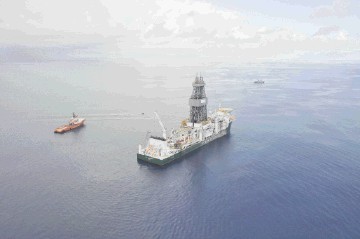
ExxonMobil with Statoil and a consortium led by Eni of Italy have made huge gas discoveries offshore East Africa, further fuelling the region’s rapid rise as a clearly important energy province.
Statoil reported cautiously in February that the deepwater exploration well Zafarani-1 being drilled offshore Tanzania on block 2 has encountered gas shows suggestive of a good quality reservoir.
On February 24, the tone changed with the company and its partner ExxonMobil talking of a “high impact discovery” of up to 5trillion cu.ft . . . “so far”.
The well encountered 120m of excellent quality reservoir with high porosity and high permeability.
The gas-water contact had not yet been established and drilling operations were on-going.
“This discovery is the first Statoil operated discovery in East Africa and an important event for the future development of the Tanzanian gas industry,” said Statoil’s exploration VP, Tim Dodson.
Yona Killaghane, MD of Tanzania Petroleum Development Corporation (TPDC) said the discovery was a potential catalyst to large scale gas developments in the country.
Zafarani is the first exploration well to be drilled on the block two licence which covers an area of some 5,500sq.km. Water depth at the well location is 2,582m. Target total depth for the well is 5,100m.
Following Zafarini-1, the drillship Ocean Rig Poseidon will shift location to drill a second block two target . . . Lavani.
Zafarani is the fifth high-impact discovery made by Statoil in the last 12 months, with the other finds being Skrugard and Havis in the Barents Sea, Johan Sverdrup (former Aldous/Avaldsnes) in the North Sea and Peregrino South in Brazil.
Statoil operates the licence on Block 2 on behalf of TPDC and has a 65% working interest with ExxonMobil Exploration and Production Tanzania Ltd. holding the remaining 35%.
The Norwegian company has been in Tanzania since 2007 when it was awarded the licence for Block 2. TPDC has the right to a 10% working interest, should any discoveries be developed, which appears inevitable given the success of Zafarani-1.
For Eni, this is the second huge gas discovery made offshore Mozambique since October 2011.
The company has reported that its Mamba North-1 discovery well on the Mamba prospect has the potential of some 7.5TCF of gas in place, bringing the total estimated gas volume for the combined Mamba South and Mamba North discoveries to some 30TCF, making it a true giant.
Mamba North 1 discovery was drilled to a total depth of 5,330m at a location about 23km north of the Mamba South-1 discovery well and 45 km off Mozambique’s Capo Delgado coast. The discovery well encountered a total of 186m of gas pay in multiple high quality Oligocene and Paleocene sands.
Eni said that during the production test, the first performed at offshore Rovuma, the well produced high quality gas with flowrates, constrained by surface facilities, of about 35.31million cu/ft per day, plus small volumes of condensates.
During the remainder of this year, the company intends to drill at least five further wells on nearby structures.
Eni is the operator of Mozambique’s Offshore Area 4 and the Mamba North-1 discovery well with 70% interest in partnership with Galp Energia, holding 10%, Korea Gas Corporation (Kogas), with 10%, and Empresa Nacional de Hidrocarbonetos (ENH), Mozambique’s national oil company, with the remaining 10%, carried through the exploration phase.
Back to Mozambique and Andarko has disclosed that its Lagosta-3 appraisal well drilled to determine the expanse and volume of the Lagosta discovery has penetrated some 176m of gas pay in multiple zones.
This well, located about 3km west of the Lagosta-1 discovery well and 15km south of the Camarao-1 well, was drilled to a total depth of some 4,180m.
By the time this appears in print, the drillship Belford Dolphin should be working on the Barquentine-4 appraisal well, also offshore Mozambique.
Bob Daniels, Anadarko’s senior VP for worldwide exploration said: “The Lagosta-3 well encountered high-quality sands and successfully confirmed an area of the field that was not as well imaged in our seismic data due to overlying faulting.”
Anadarko has two deepwater drillships operating in the discovery area offshore Mozambique, the second, the Deepwater Millennium, was at the last count conducting a drill-stem test on the Barquentine-2 well to assess its viability.